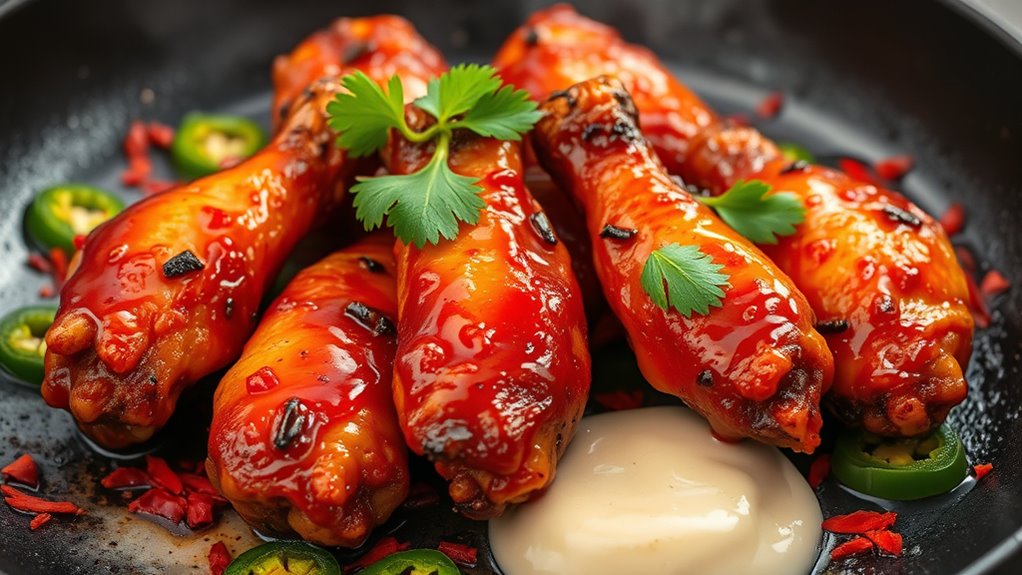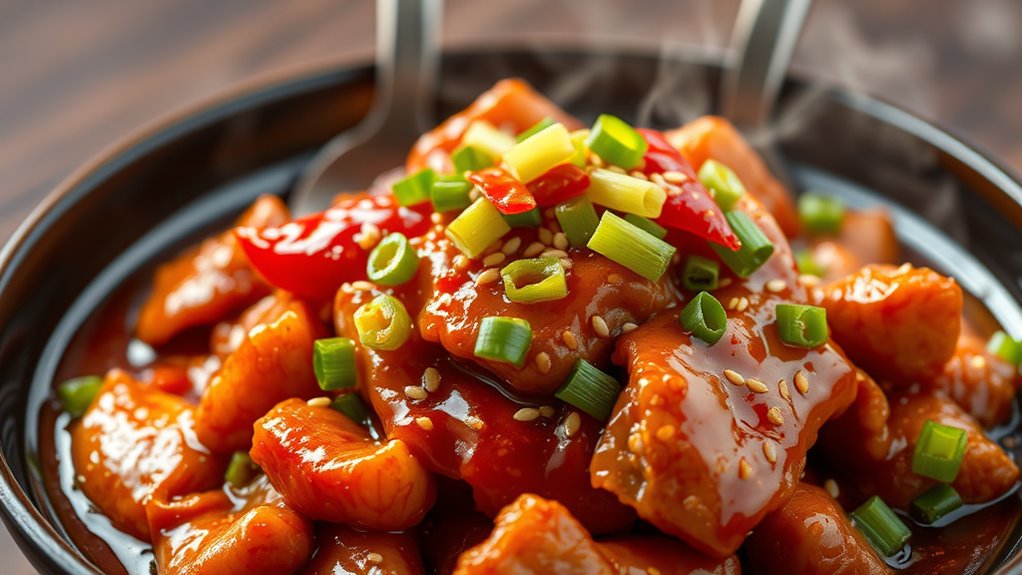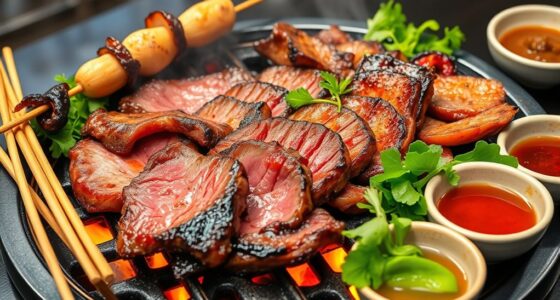Chili-forward cuisine is taking center stage as bold, spicy, and smoky flavors blend with sweet elements to create “swicy” dishes that excite your palate. You’ll notice regional influences shaping unique spice mixes and ingredient choices, making each dish authentic and vibrant. These dishes celebrate tradition while pushing culinary boundaries with inventive flavor combinations. If you’re curious about how these fiery creations connect to culture and innovation, you’ll find more fascinating details ahead.
Key Takeaways
- Chili-forward cuisine emphasizes bold spice blending, balancing heat, smokiness, and depth to create layered flavors.
- Regional influences like Texas and the Carolinas shape authentic chili dishes with unique spice combinations.
- The trend of “swicy”—combining sweet and spicy elements—adds complexity and broadens flavor profiles.
- Use of traditional, regional ingredients ensures authenticity and reflects cultural culinary evolution.
- The cuisine celebrates storytelling through spice craftsmanship, blending tradition with innovative, vibrant flavors.

Have you ever tasted a dish that boldly combines smoky, spicy flavors with hearty ingredients? If you have, then you already know why chili-forward cuisine is taking the culinary world by storm. This style of cooking emphasizes the art of spice blending—carefully balancing heat, smokiness, and depth to create dishes that excite the palate. It’s not just about adding heat; it’s about crafting a symphony of flavors that reflect regional flavors and cultural traditions. From the robust chilis of the American Southwest to the fiery, spice-laden dishes of Mexico and beyond, chili-forward cuisine celebrates the diverse ways different regions interpret heat and flavor.
Chili-forward cuisine masterfully blends smoky, spicy flavors reflecting regional traditions and cultural stories.
The essence of this cuisine lies in understanding regional flavors and how they influence spice blending. In Texas, smoky chipotle peppers are often combined with cumin and garlic to produce a rich, layered flavor profile. Meanwhile, in the Carolinas, a mix of cayenne, black pepper, and vinegar creates a tangy, spicy barbecue sauce that highlights local traditions. These regional influences shape every dish, making each one a reflection of its origin. As you explore chili-forward dishes, you’ll notice that the spice blends aren’t just about heat—they tell stories about the land, climate, and cultural history behind them. Additionally, the use of natural ingredients ensures that each dish maintains its authenticity and vibrant flavor profile.
What sets this cuisine apart is its versatility. Some dishes are intensely spicy, designed to challenge your palate and bring a fiery kick, while others incorporate just a hint of heat to enhance the underlying flavors. The trend now leans toward “swicy”—a blend of sweet and spicy—that adds an unexpected twist. Think honey-glazed ribs with a spicy rub or a chili-infused chocolate sauce. This balance of sweet, smoky, and spicy creates a complex flavor profile that keeps you coming back for more. The use of regional flavors ensures that each dish feels authentic and rooted in tradition, even as chefs experiment with new combinations.
Frequently Asked Questions
How Did Chili-Forward Cuisine Originate Historically?
You might not realize it, but chili-forward cuisine originated through chili cultivation and the spice trade. As chili peppers were cultivated in regions like Central and South America, traders brought them to Europe and Asia, where people started experimenting with their fiery flavors. Over time, cultures incorporated chili into their dishes, creating a tradition of spicy cuisine that spread globally, shaping the bold, hot flavors we enjoy today.
What Are the Health Benefits of Spicy Ingredients?
Spicy ingredients like chili peppers boost your health by increasing spice tolerance and offering capsaicin benefits. Capsaicin, the compound that makes peppers hot, may help reduce inflammation, improve metabolism, and support weight loss. It also stimulates endorphin release, lifting your mood. Regularly enjoying spicy foods can strengthen your body’s response to heat, making you more tolerant over time, while providing these potential health perks.
Which Regions Are Most Associated With “Swicy” Dishes?
You’ll find “swicy” dishes most associated with regions known for bold, diverse flavor profiles, like the American South and parts of Asia. These areas embrace spicy fusion cuisines that blend local ingredients with international heat, creating unique regional flavor profiles. In the U.S., you’ll see this trend in cities that celebrate culinary innovation, while in Asia, spicy fusion cuisines reflect a mix of traditional and modern influences, making each region’s dishes exciting and distinct.
How Does Spice Level Impact Flavor Pairing?
Spice level can transform your dish from bland to mind-blowingly complex. When you add heat, it’s like igniting a fireworks show on your palate, demanding expert flavor balancing. You’ll find that a sweet contrast can mellow the heat, creating a harmonious blend. Too much spice, though, can overpower subtle flavors, so you need to carefully consider how heat impacts overall flavor pairing for the perfect bite.
Are There Cultural Sensitivities Around Spicy Food?
You should be aware that cultural sensitivities around spicy food exist because some cultures view certain ingredients as sacred or traditional. Respect spice tolerance differences, and avoid cultural appropriations by understanding the origins of spicy dishes. When experimenting with spicy flavors, consider these sensitivities to honor authentic cuisines and avoid offending communities. Always aim for appreciation rather than appropriation, ensuring your culinary explorations are respectful and inclusive.
Conclusion
Get ready to set your taste buds ablaze because chili-forward cuisine is taking over, transforming every dish into a fiery masterpiece. With each spicy bite, you’ll feel like you’re riding a rollercoaster through a volcano, bursting with heat and flavor. This isn’t just food—it’s an explosive adventure that leaves your mouth tingling and your senses begging for more. Embrace the heat, because in the world of “swicy,” you’re about to become a blazing hero of flavor.









